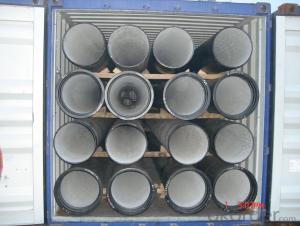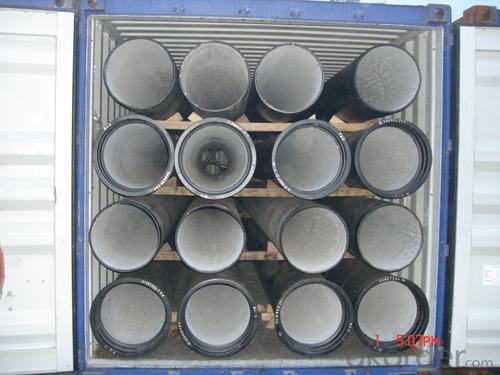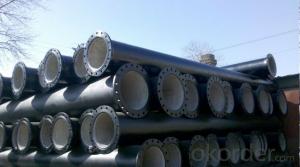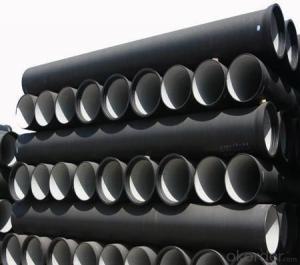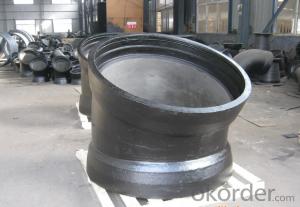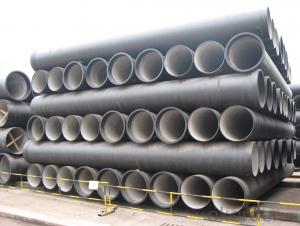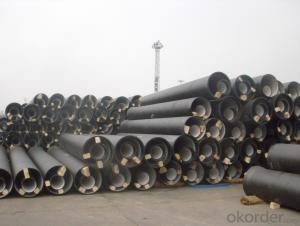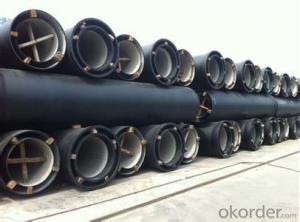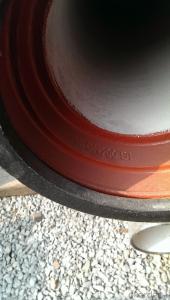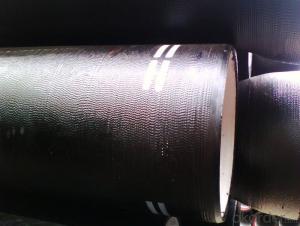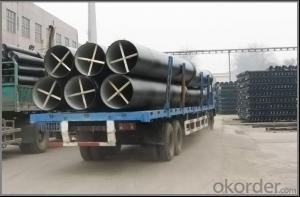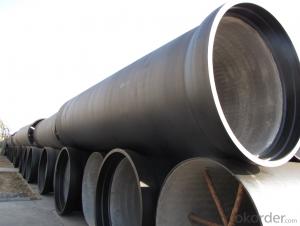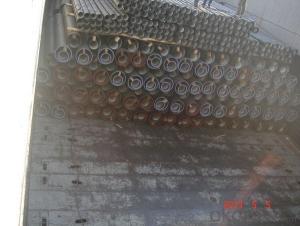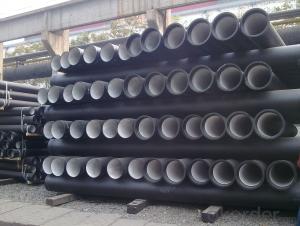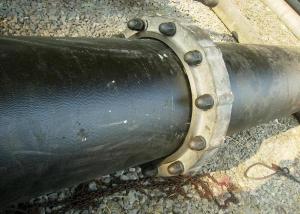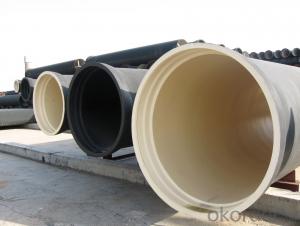ductile iron pipeDN125 K9 socket spigot pipes
- Loading Port:
- Tianjin
- Payment Terms:
- TT OR LC
- Min Order Qty:
- 25
- Supply Capability:
- 30000 /month
OKorder Service Pledge
OKorder Financial Service
You Might Also Like
1) The standard of pipe: ISO2531:1998, EN545:2006,K9 K8
2) Effective length: 6m/5.7m
3) Inner cement line: Portland cement lineas per ISO4179
4) Zinc coating: at least 130g/m2 as per ISO8179
5) Bitumen painting: at least 70μm as per ISO8179
6)With 102% quantity of NBR, SBR, or EPDM ring asper ISO4633
7) DN80-DN1200
8) Highstrength, lighter than grey iron, good corrosion resistance, no furring, smallflow resistance, easy fixing, long life tome about 100 yeas
9)Checked by automatic inspection equipment
10) Composition:
Chemical composition | |||
Chemical composition | Ductile Cast Iron Pipe (%) | Grey iron pipe (%) | Steel pipe (%) |
C | 3.5-4.0 | 3.2-3.8 | 0.1-0.2 |
Si | 1.9-2.6 | 1.4-2.2 | 0.15-0.4 |
Mn | 0.15-0.45 | 0.4-0.6 | 0.3-0.6 |
P | ≤0.06 | ≤0.3 | 0.02-0.03 |
S | ≤0.02 | ≤0.1 | 0.02-0.03 |
Mg | 0.03-0.06 |
|
|
11) Feature:
Mechanical properties | |||
| Ductile Cast Iron Pipe | Grey Iron Pipe | Steel Pipe |
Tensile Strength(Mpa) | ≥420 | 150-260 | ≥400 |
Yield Strength(Mpa) | ≥300 | No Confirmation | No Confirmation |
Bending Strength(Mpa) | ≥590 | 200-360 | ≥400 |
Elongation (%) | ≥10 | Neglected | ≥18 |
Brinell Hardness(HBS) | ≤230 | ≤230 | About 140 |
12) T type mechanical joint
13) Packing: in bulk or container
PACKING: 1) Pipesare bundled together with the steel belt.
2) Wooden pieces are put between the pipes.
- Q: How do ductile iron pipes perform in high-temperature water applications?
- Ductile iron pipes perform well in high-temperature water applications due to their inherent strength and durability. They can withstand the elevated temperatures without losing their structural integrity, making them an ideal choice for conveying hot water.
- Q: What are the different methods for joining ductile iron pipe?
- There exists a variety of methods to join ductile iron pipe, each possessing its own advantages and limitations. One commonly utilized technique is the mechanical joint (MJ) coupling, where a rubber gasket, bolts, and nuts are employed to establish a watertight seal between pipe sections. This method is comparatively swift and straightforward to install, although it necessitates the expertise of a skilled technician to ensure proper alignment and bolt tightening to prevent leakage. Another approach is the flanged joint, which involves equipping the pipe ends with flanges that are fastened together using gaskets to form a secure seal. This method permits easy disassembly and reassembly of pipe sections, making it suitable for applications requiring frequent maintenance or alterations. However, it is more costly and time-consuming when compared to other methods. A widely employed method is the push-on joint (POJ), wherein a rubber gasket and a special lubricant are utilized to slide the pipe ends together. This technique yields a reliable and watertight seal, and installation is relatively rapid and simple. However, it necessitates proper alignment and cautiousness to prevent damage to the gasket during assembly. An alternative option is the restrained joint (RJ), which utilizes a mechanical joint coupling with additional features to resist axial forces or thrusts. This method is commonly employed in applications where the pipe is subjected to internal pressure, external loads, or seismic activity. It offers a secure and rigid connection but may require specialized tools and training for installation. Lastly, welding is another method for joining ductile iron pipe. This involves heating the pipe ends and melting a filler metal to create a permanent bond. Welding provides a strong and durable connection, but it demands skilled welders and additional time for preparation, welding, and cooling. It is often employed for specific applications, such as joining sections of pipe with different diameters or connecting to other materials. In conclusion, the various methods for joining ductile iron pipe encompass mechanical joint coupling, flanged joint, push-on joint, restrained joint, and welding. The selection of the method relies on factors such as application requirements, installation time, maintenance needs, and budget.
- Q: Why is the sound speed of nodular cast iron lowered after heat treatment?
- This may be the material microstructure changes after heat treatment, is generally the pearlite content increased, the available change heat treatment and then check the corresponding microstructure and corresponding measuring sound velocity adjustment, such as annealing, normalizing etc..
- Q: Are ductile iron pipes suitable for pressure reducing valve stations?
- Ductile iron pipes prove to be suitable for pressure reducing valve stations due to their strength and durability, making them an ideal choice for applications involving high pressure. Pressure reducing valve stations, which regulate and decrease the pressure of a fluid or gas in a pipeline system, can rely on ductile iron pipes to handle the exerted pressure, ensuring an efficient and reliable operation. Moreover, the excellent resistance to corrosion exhibited by ductile iron pipes is crucial in upholding the integrity of the pipeline system, thereby preventing leaks or failures. Overall, the necessary strength, durability, and corrosion resistance required for pressure reducing valve stations are provided by ductile iron pipes.
- Q: Is ductile iron pipe breakable?
- 1 、 the drainage pipe is easy to fold. Folding is formed on the surface of various drainage pipe line, the longitudinal defects often throughout the entire product;2, poor drainage pipe surface prone to scarring;3, inferior drainage pipe, no metallic luster, is pale red or similar to the color of pig iron;4, inferior drainage pipe easily scratch, because the inferior material manufacturers equipment is simple, easy to produce burr, scratches the drainage pipe surface. Deep scrape reduces the strength of the ball drain;
- Q: Can ductile iron pipes be used for potable water systems?
- Yes, ductile iron pipes can be used for potable water systems. Ductile iron is a strong and durable material that is resistant to corrosion and has been widely used in water distribution systems for many years. It meets the necessary standards and regulations for the transportation of potable water, making it a suitable choice for such applications.
- Q: Can ductile iron pipes be used for underground geothermal systems?
- Indeed, underground geothermal systems can utilize ductile iron pipes. Renowned for their robustness, endurance, and immunity to corrosion, these pipes are apt for myriad purposes, encompassing underground geothermal systems. They possess the capacity to withstand elevated temperatures and pressures, rendering them optimal for conveying scorching geothermal fluids. Moreover, ductile iron pipes boast a protracted lifespan and the ability to endure the soil shifts and strains inherent in subterranean installations. Consequently, they represent a dependable selection for underground geothermal systems.
- Q: What is the difference between cast iron pipe and seamless steel pipe and galvanized steel pipe?
- Seamless steel pipe: a pipe with a hollow cross section, used as a conduit for transporting fluids, such as pipelines for transporting petroleum, natural gas, gas, water, and certain solid materials. Compared withsteel and roundsteelinsolid, flexural torsional strength in the same time, the weight is light, is a kind of economic section steel, widely used in the manufacture of structural parts and mechanical parts, such as the oil pipe, automobile transmission shaft, the bicycle frame and steel construction with scaffold with steel pipe manufacturing ring parts can be improved the utilization rate of materials, simplify the manufacturing process, material saving and working hours, has been widely used to manufacture steel tube.
- Q: Can ductile iron pipes be used for marine applications?
- Yes, ductile iron pipes can be used for marine applications. Ductile iron has excellent corrosion resistance properties, making it suitable for use in marine environments where exposure to saltwater and other corrosive elements is common. Additionally, its high strength and durability make it a reliable choice for various marine applications such as seawater intake and discharge systems, offshore platforms, and marine pipelines.
- Q: What is the typical lifespan of ductile iron pipes?
- The typical lifespan of ductile iron pipes can vary depending on various factors such as the quality of the pipes, the environmental conditions, and the maintenance practices. However, on average, ductile iron pipes have a lifespan of around 75 to 100 years. This makes them a durable and long-lasting option for water and sewage transportation systems. With proper installation and regular maintenance, these pipes can withstand corrosion, pressure, and other external factors, ensuring their longevity and reliability. Additionally, advancements in coatings and linings have further enhanced the lifespan of ductile iron pipes, making them an excellent choice for infrastructural projects.
Send your message to us
ductile iron pipeDN125 K9 socket spigot pipes
- Loading Port:
- Tianjin
- Payment Terms:
- TT OR LC
- Min Order Qty:
- 25
- Supply Capability:
- 30000 /month
OKorder Service Pledge
OKorder Financial Service
Similar products
Hot products
Hot Searches
Related keywords
